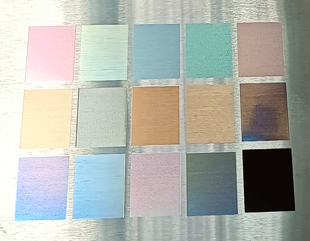Color laser marking is a specialized process that enables the creation of colored markings on materials, primarily metals, by adjusting the laser’s parameters such as pulse width, frequency, and power. This technique is primarily used in high-precision industries and has unique applications.
Please see below for specific parameters setting in this video.
Main Applications of Color Laser Marking
Consumer Electronics and Personalization
Color laser marking is commonly used for adding logos, branding, and personalization on electronic devices, such as smartphones, laptops, and accessories. It’s especially valuable in customizing metal cases with durable, colorful engravings.
Luxury Goods and Jewelry
The ability to create high-quality, multi-colored engravings makes color laser marking popular for high-end jewelry, watches, and luxury items. Brands use this technology to add fine, detailed logos, designs, and serial numbers that enhance product exclusivity.
Automotive and Aerospace Components
Color laser marking is ideal for adding color-coded identification on components, making it easier to distinguish between parts and enhancing traceability in the production line. It’s frequently used for marking metal parts, labels, and even interior trim elements in vehicles.
Medical Devices and Instruments
Medical devices often require color-coded markers for easier identification and compliance. Color laser marking can apply permanent markings on surgical instruments, implants, and diagnostic tools, providing durable color codes that withstand sterilization and cleaning processes.
Industrial Tooling and Manufacturing Parts
In manufacturing, color laser marking can add color-coded information on tools and parts, making it easier for operators to identify and select the correct tools. This is helpful for complex systems where precise tools and components are required.
Decorative Applications in Art and Design
Color laser marking allows artists and designers to create detailed, multi-colored engravings on metals, offering new creative possibilities. This technique is especially popular for personalized art pieces, awards, and custom decor.
How Color Laser Marking Works?
Color in laser marking is achieved by manipulating laser parameters to create oxidation on the metal surface or changing the metal’s refractive properties, which alters how light reflects and creates color. By controlling settings like speed, power, frequency, pulse width and fill spacing, a wide range of colors can be marked on stainless steel and other metals. The color laser marking parameters setting on stainless steel in above video are as follows:
| The Parameters of Color Marking on Stainless Steel | |||||
| Galvo Model:SG7210-A | |||||
| Laser:60W JPT MOPA Laser | |||||
| F-theta Lens:F254 | |||||
| Color | Speed(mm/s) | Power(%) | Frequency(kHz) | Pulse Width(ns) | Fill spacing(mm) (Bow Shaped) |
| Purple | 800 | 30 | 250 | 60 | 0.001 |
| Light Green | 500 | 90 | 200 | 4 | 0.002 |
| Blue | 500 | 30 | 360 | 10 | 0.002 |
| Green | 800 | 25 | 360 | 13 | 0.001 |
| Light Pink | 1300 | 70 | 600 | 4 | 0.001 |
| Beige | 1000 | 60 | 200 | 10 | 0.001 |
| Grey | 1000 | 60 | 700 | 200 | 0.001 |
| Brown | 1000 | 50 | 80 | 25 | 0.004 |
| Gold | 500 | 50 | 100 | 30 | 0.03 |
| Light Gold | 1500 | 60 | 120 | 13 | 0.001 |
| Gradient Blue | 800 | 30 | 250 | 50 | 0.005 |
| Light Blue | 800 | 30 | 500 | 50 | 0.005 |
| Light Purple | 1000 | 60 | 300 | 10 | 0.001 |
| Blue-Grey | 1000 | 50 | 80 | 30 | 0.004 |
| Black | 800 | 55 | 150 | 30 | 0.001 |
- Laser Frequency: Higher laser frequency produces more pulses in the same time frame, which increases heat and can lead to darker, more intense colors.
- Speed: Faster speed reduces the laser’s contact time with the material, resulting in lighter colors, while slower speed allows for deeper marking and potentially darker shades.
- Pulse Width: A shorter pulse width delivers intense bursts of energy, often creating lighter, finer markings, while a longer pulse width produces more heat, leading to darker and deeper colors.
- Fill spacing: Closer fill spacing increases overlap between laser passes, resulting in darker, more solid colors, while wider spacing lightens the color as the laser marks less densely.
- Power: Laser power affects color marking by changing the heat applied to the material, with higher power creating darker, more intense colors and lower power producing lighter shades. Adjusting power lets you control the depth and appearance of color on the surface.
Color laser marking is a unique value add, allowing industries to mark parts with durable, colorful, and precise designs that enhance both functionality and aesthetic appeal. If you are interested in color laser marking, please feel free to contact us.

